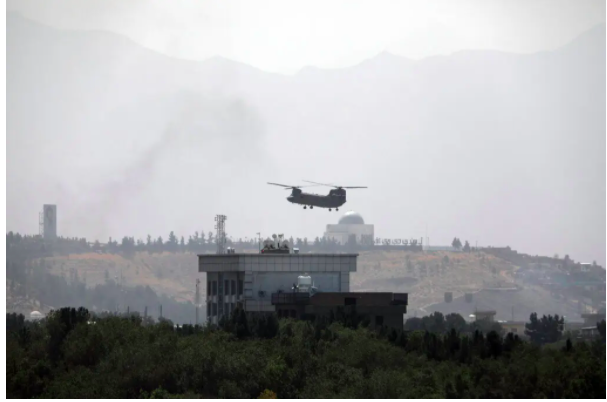
The Fall of Afghanistan: How We Spent A Trillion Dollars To Replace The Taliban With The Taliban
The rapid fall of Kabul, the capital of Afghanistan, on August 15th without a serious fight and the flight of the deposed president Ashraf Ghani, reportedly with several cars and a helicopter full of cash, heralded the inglorious end of America’s near two decade attempt to “nation-build” Afghanistan in its own image. The fact that the fall of the Afghan government, which had been supported by international coalition forces, fell even prior to the American departure of its military, intelligence, and diplomatic assets out of the country only added insult to injury. The fall was not surprising to many critics, but the speed of it all was. The situation in Kabul was so terrible that the United States had to beg the Taliban, a force once described by General Wesley Clark as “the most incompetent adversary the United States has fought since the Barbary pirates”, to spare its embassy and to ensure safe passage of the staff out of the country. The US even offered aid as an inducement for the Taliban to allow safe passage for its staff. The American exit from the country was also marked by airport bombingsthat killed 13 American service members and scores of Afghanis. The bungled withdrawal, has also led to American’s international allies being placed at risk and questioning the judgment of her leader. The British parliament held President Joe Biden in contempt by a unanimous vote. Many other European leaders expressed their shock at how poorly the withdrawal was conducted and noted that their faith in American leadership had been damaged by this affair.
This exit from the country has larger consequences. As America withdraws, China, the main great power rival to the United States, is set to fill the power vacuum by attempting to get the Taliban led government within its sphere of influence. This is evident by China already announcing it is ready to recognize the Taliban as the legitimate governors of Afghanistan. Russia, another major power, is also mulling recognition. This prospect of recognition by two major powers stands in contrast to the West's attitude toward the new regime which is one of non-recognition and the West attempt to lobby the international community to adopt a similar policy. China has eyed economic opportunity in extracting the rare earth resources in the country and China has noted that their strategic economic initiative to shift the trade routes of the world economy can run through Afghanistan. China also sees a détente with the Taliban as a means to cut off previous Taliban support for the East Turkestan Islamic Movement, which is an Islamist separatist group in China. Whether Afghanistan finally stabilizes under the Chinese sphere of influence or whether it once more erupts into internal discord and resists Chinese influence remains at this juncture an open question.
Twenty years after being removed from power by the US, as they formally proclaimed an Islamic Emirate in the country, the triumph of the Taliban seems complete. All this serves to suggest that the foreign presence in the country was not accomplishing any strategic goal America set, and the military occupation only managed to delay this Taliban takeover. This realization of at least the former point finally made policymakers arrange what was planned to be an honorable exit. President Trump had reached a withdrawal deal with the Taliban in 2020, which President Biden unilaterally scrapped. Instead, President Biden announced a longer timetable of withdrawal that moved the date of departure from May 1st to September 11th. He also changed the nature of the withdrawal from being conditions based to unconditional and moved to disband a Trump created bureau that was dedicated providing support to overseas Americans in the event of a crisis.
Yet, here strategic blindness to the situation on the ground appeared commonplace. President Biden in a speech in July touted the superior numbers and equipment of the Afghan army over the Taliban, proclaiming that the fall of the national government was by no means a foregone conclusion and denied that there was intelligence assessments to the contrary (this turned out to be inaccurate). General Mark Milley, chairman of the Joint Chiefs of Staff, made similar remarks in July. Emblematic of the war at large, what was predicted to be an honorable exit quickly turned into a fiasco. Over-optimistic military assessments about the capacity of the Afghan army to resist the Taliban were rudely upset with many key cities in the country, Kabul included, surrendering without a serious fight. Despite insistences by Anthony Blinken, the Secretary of State, that what was unfolding in Kabul with the Taliban takeover and the frenzied rush to evacuate personnel was not anything like the American evacuation from Saigon and that America succeeded in its mission, such comparisons by the press were made.
The fact the United States finally withdrew from its most disastrous war since Vietnam was not the problem. The problem was strategic shortsightedness in entering Afghanistan and staying as long as America did, as well as carrying out a disastrous pull-out plan that led to a frenzied embassy rooftop evacuation and a chaotic rush to the Kabul airport by civilians.
From its inception, the American mission in Afghanistan was a moving goal post. Originally, the American invasion of Afghanistan was billed as an attempt to avenge the tragedy of 9/11 by waging an expansive “war on terror” to eradicate any terrorist and their state sponsors anywhere. In Afghanistan’s case, this war was to be waged on the members of the Islamist terrorist organization al-Qaeda, the organization responsible for the 2001 9/11 attack, and those like the Taliban who hosted these organizations in their countries.
If the object was to get the leaders of al-Qaeda like its principal leader Osama Bin Laden, then this could have been achieved through less interventionist means – but the US apparently had other plans. The Taliban offered to hand Bin Laden over prior to any military operation in Afghanistan, providing the United States gave them evidence he was behind 9/11. The ground invasion arguably could have been altogether avoided, as the Taliban reiterated their offer with the additional caveat that the Americans ceased their bombing campaign. Both offers were rejected by President Bush. The subsequent invasion of Afghanistan failed to capture Bin Laden, as he escaped to Pakistan after a close shave with American and the US allied Afghan troops in Tora Bora. His escape was made possible by the Pakistanis failing, perhaps intentionally, to secure their part of the border, infighting among America’s Afghan allies, and a lack of commitment of forces by American officials, who would miss other opportunities to cripple al-Qaeda by sending resources to Iraq, a country where al-Qaeda did not exist. Bin Laden was finally hunted down and killed in Pakistan in 2011, which should have signaled the end of the campaign given the declared goal of taking out the leadership of those responsible for the 9/11 attack, yet American forces remained in Afghanistan for ten more years.
Another goal post that was used to justify continued US presence in Afghanistan was that a phase of nation building was necessary to make the country self-governing. President Bush would gave a number of speeches where he would laud that under American tutelage, Afghanistan was to become more democratic, stable, a better place for women, and so on. Bush used gender advancements as a reason for the continuation of the war. Other politicians like Joe Biden would also encourage a long-term commitment of American blood and treasure being spent to make the country self-sufficient by eliminating corruption, warlordism, illiteracy, poverty, and the drug trade within the country.
There were expectations by the Americans that the Afghan army would be self-reliant and take over security matters by 2008. When this did not come to fruition, the date was moved by the Obama administration to 2014, however, even after this date there were questions regarding the seriousness of the Afghan army as a fighting force. The rapid collapse of the country during the US withdrawal proved those critics of the independence of the Afghan army right. Overall, about $1 trillion was spent in the name of securing Afghanistan by the US.
Yet, at every turn this nation building fell short. The United States failed to stop and even abetted the endemic corruption plaguing the national government as the CIA doled out money to any warlord, government official, and religious leader to buy loyalty, votes, and information. As much as 40 percent of American aid was used in this way. Nor did the majority of the aid stay in the war-torn country as 80-90 percent of American investment in Afghanistan found its way back to the US through a complex system of defense and aid contractors who in turn used the money for corrupt purposes and delivered substandard services to the Afghan army. During the course of the war on terror, US military officials even knowingly funded the Taliban insurgents it was fighting to let their convoys pass. Corruption was systemic in the Afghan army, where practices like using “ghost soldiers”, inflating the military troop strength with fictitious personnel to pocket more cash, was readily used. American officials readily manipulated statistics for public consumption that suggested the war was being won while privately admitting this was an unwinnable venture. Similarly, the attempt to rid Afghanistan of its opium production by the Americans failed spectacularly as the amount of opium production by the country rose from 180 metric tons in 2001 to 6,400 tons in 2019. To the extent any nation building was being done, it was being done by mass corruption and was only making the national Afghan government a client state that was wholly dependent on American aid to survive.
In the end, Afghanistan shows the folly of American overreach. The initial war aims might have been achieved peacefully from the beginning; and once the country was under military occupation - a listlessness of aims set in. From hunting down those responsible for 9/11 the goal now was to engage in a nebulous process called nation building to make the country able to govern itself (in a more liberal style). This process was broad, as it included attempting to restructure Afghan society to make the very conservative society more like the West, as well as focusing on getting the Afghan army to secure the country. Rampant corruption plagued this process and made the national government more dependent on international assistance to keep the Taliban at bay. The rapid collapse of the national government to the Taliban in all but one province while the United States was still removing its forces denied an honorable exit to the United States.
The takeaway lesson for the United States from this nearly 20-year debacle should be that the country and its leaders must think in geostrategic terms and about the ways in which its actions benefit or harm its long term aims. American foreign policy should be driven by well-defined aims. The intervention in Afghanistan, as this article shows, was not. Staying in Afghanistan and spending a vast amount of time, resources, and manpower on a corrupt and inept national government was detrimental while China grows economically, politically, and militarily.
Such time, resources, and manpower could have been devoted toward more meaningful and productive projects of containing China or addressing other issues that America faces. The United States should seek to befriend and support governments which have public legitimacy and a willingness to defend themselves by themselves rather than prop up a regime that has none of these qualities. In a sentence, the United States should play the game of international relations based on realist principles rather than act out in a blind ideological fashion. If the United States does this, it should avoid another scenario like Afghanistan.
